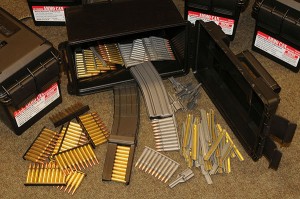How to Properly Store Ammo
19th Aug 2014

Avoid Extreme Heat
Modern, factory-loaded rounds are designed to function reliably in conditions ranging from the arctic to the tropics. Therefore as long as you prevent exposure to extreme heat, high humidity and temperature fluctuations, your ammunition can be expected to last 10 years.
According to Rick Patterson, Managing Director of SAAMI, “In fact as long as your ammunition is stored at normal room temperatures with low humidity, it can function reliably for decades.”
It takes more than just a warm day to detrimentally impact ammunition—SAAMI believes the breakdown begins around 150 degrees Fahrenheit. There are very few environments where stored ammo can reach those extremes, but the trunk of a vehicle is one of them.
“Definitely avoid storing ammunition in a car on a hot sunny day—that’s probably the single most likely scenario that could cause problems for the average shooter,” Patterson explained. “With extremely high temperatures, you get rapid degradation of the ammunition components. The case and bullets are relatively inert in terms of temperature, but the chemical properties of the gunpowder and priming mixture can be affected … Over time, you’ll see a drop in performance, perhaps to the point of going click rather than bang.”
Theoretically, extreme cold could eventually impact ammunition, but it isn’t worth your concern. High heat kills otherwise good ammo, and that’s the primary thing to avoid in regards to temperature. Rapid fluctuations could, however, also prove detrimental over time. So if you’re among the many Americans storing shells in garages, perhaps you should reconsider.
“It’s easy to forget just how much conditions vary through the year, let alone over the course of many years,” said Tim Brandt, Media Relations Manager for Federal Premium Ammunition. “Here in Minnesota it can hit 100 degrees in the summer and negative 30 in the winter.”
Keep Your Powder Dry
Ensuring a low-humidity environment is another storage priority. According to Patterson, “there’s no hard-and-fast level to strive for, but generally the lower the better.”
If your basement smells damp or occasionally spawns mildew, it’s not ideal for ammo storage.
“One of the biggest issues caused by humidity is corrosion of the brass casing and perhaps even the bullet,” Patterson said. “Number one that changes the dimensions of the case and creates friction, which may not allow the cartridge to seat in the chamber correctly. It could also weaken the cartridge, so take a look at the external conditions of the case—if you see evidence of corrosion, the damage may make the shells unsafe to shoot.”
In cases of very high humidity—or direct exposure to water or household solvents such as oil, ammonia or paint thinner—moisture can seep in and ruin ammo.
“Premium ammunition manufacturers take extra steps to seal the cartridges at the two most obvious seams—at the primer and around the bullet,” Patterson said. “Premium waterfowl loads are also sealed at the primer and crimp. Still, always avoid exposure to high humidity, water or chemicals.”
Therefore, consider storing your ammunition off the ground in a sealed, plastic container. I also keep a dehumidifier near my ammunition, particularly during the spring and summer months. I’ve had good luck with those from General Electric in terms of effectiveness and durability.
For most shooters, these precautions are plenty. However, if your ammunition will be stored for many years in a potentially humid environment—perhaps at your cabin on the lake—there are products designed to further inhibit corrosion. Most are sealed bags or plastic and metal containers designed to lock out moisture. One such product is the Federal Champion .22 Long Rifle Fresh Fire Pack. It consists of 325 .22 LR cartridges, packed in a nitrogen-sealed can that locks out moisture.
Then there are the many types of Russian-made, surplus “Spam Cans.” The steel cans are sealed tightly against air and water, requiring a special tool or screwdriver to pry them open. Some shooters swear by these cans to keep ammo fresh for decades. The cans are commonly shipped with 7.62×39 or 7.62x54R loads—quantity varies, but 640 rounds is typical.
What about the not-so-airtight storage containers such as those available through U.S. military surplus? Many of them have a rubber O-ring around the rim to lock out gas and moisture. You can improve the strength of this seal by applying a very light coat of gun oil or WD-40.
The Good News
Luckily, as long as you adhere to these basic recommended guidelines, you’re almost certain to get a decade of use out of every box of shells. Our grandfathers couldn’t expect that.
“When you look at advances in chemical technology, some of the world’s greatest innovations are taking place in ammunition and gunpowder,” Patterson notes. “The consistency across a broad range of conditions is really amazing. Much better than 20 or even 10 years ago.”
So, keep your powder dry. Also avoid high heat, store in a stable, room temperature environment and prevent exposure to moisture and humidity. As long as you aren’t among the few retro shooters who enjoy paper shotgun hulls—which are extra sensitive—these rules are sufficient to preserve all types of ammo, from rimfire to centerfire to shotshells.
